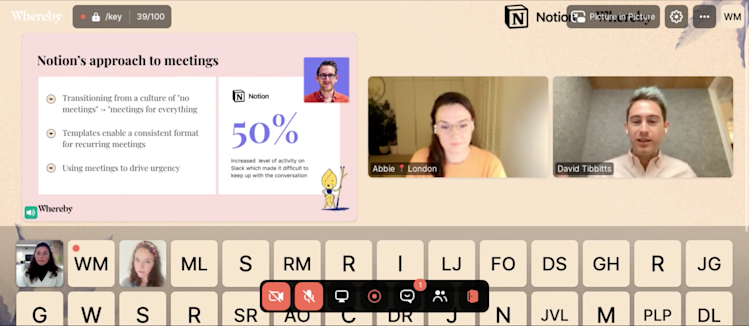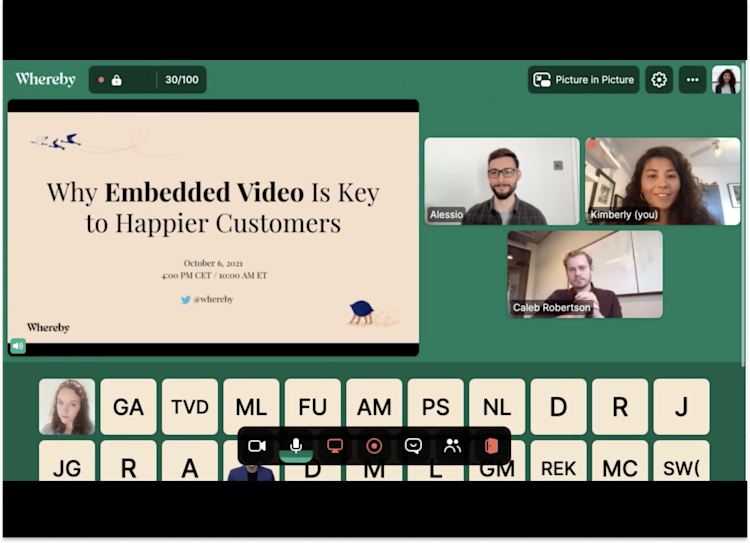Insider Tips for Creating Engaging Hybrid Events
Events have changed a lot since the first Covid lockdowns two+ years ago.
In those early days, everyone was forced to adapt under pressure. Going from zero to fully remote was no small task, and caused a lot of disruptions. But, as the initial chaos began to settle and vaccines started allowing for slightly more normal interactions, companies started offering hybrid events that blend in-person and virtual elements in an effort to cater to the broadest audience.
Having learned through trial by fire how much is possible in a virtual space, many companies have begun investing more time and effort into learning how to have the best of both worlds—the virtual one and the real one—for themselves and their event attendees.
We recently had the opportunity to speak with three people who have had first-hand experience both hosting and attending hybrid events. Luke Richardson is the Director of Brand and Communications at Pleo, which recently hosted the Forward conference featuring a combination of in-person and digital speakers addressing a digital audience. Ashley Jenkins, the Events Manager at Miro, took on the role at the height of the pandemic, and has since worked on a variety of events including webinars, sponsored events, and Miro’s flagship user conference. Mats Mileblad is the CEO at vVenues, a brand experience platform specifically designed to deliver a truly engaging virtual experience.
We had an in-depth conversation about what makes a great hybrid event, how to engage people well in a virtual setting, what role video can play, and how this new approach to events can help improve accessibility and inclusivity.
You can listen to the webinar replay here, or read on for all the top highlights.
What is a hybrid event, and how does hybrid give you an advantage?
A hybrid event is one that combines in-person and virtual elements—both in terms of the experience and the audience. As Ashley points out, however, that’s a definition that exists on a spectrum, meaning that the emphasis might be on either virtual or in-person. “It’s really tough to have an even 50/50 split with hybrid events. Say I have an event with 20,000 people—5,000 in person and 15,000 virtually—those will be two different experiences,” she explains. “The key is to ensure that each group has an equitable experience.”
Luke added that the qualifier that a good hybrid event is one that prioritizes the virtual experience as much as the in-person experience. “You don’t want attendees to feel like they are just blankly looking at a screen all day,” he says. “You want them to feel really engaged throughout the whole experience.” If you haven’t attended a hybrid event, you can get a sense of how the blend of in-person and virtual can go wrong if you’ve ever been the one remote person in a meeting where everyone else is sitting around the conference table. There’s a definite “odd-man-out” dynamic that quickly alienates the person calling in.
One of the beautiful things about hybrid events—when they are done well—is that they provide an unprecedented opportunity to broaden your audience. “Hybrid events help you maximize your exposure,” says Ashley. “If someone is unable to travel or is a working mom who wants to attend multiple events, having a virtual option can really open up the options. In addition, having a virtual element makes it easy to provide live translations, closed captioning, and on-demand sessions, all of which help make your content more accessible.”
Mats points out that including a virtual element can also be good for the planet and your bottom line. “The nature of virtualization means that you don’t have to travel, which both saves money and improves your ecological footprint,” he explains. He goes on to add that including virtual elements in a hybrid event can also open things up for introverts, “I have a wonderful story from a very shy woman in tech who wrote in a post-event report that our hybrid event was the first one where she felt really included because the virtual nature of the interactions made it possible for her to participate on equal terms with everyone else in the room.”
Finally, Luke makes the very valid point that a hybrid event format can also help you level up your program quality. “Hybrid gives you the ability to cast your net wider, and bring in rockstar speakers that may otherwise have been completely out of reach,” he says.
How to think about your hybrid engagement strategy.
Once you’re sold on a hybrid approach for your event, one of the most critical things to work on is ensuring that your event is equally engaging for all your attendees, whether they will be joining you in the real world, or tuning in via virtual connections.
“Ultimately, you want your virtual experience to recreate the physical event space. It’s very important that you can interact with both the virtual and physical audiences, and that they can find easy ways to communicate with each other,” says Mats. “This means using a platform that provides a fully integrated way to facilitate virtual networking and breakout sessions. We use Whereby technology to integrate virtual meeting rooms into our experience, and allow our attendees to search for people, engage via text, and pop right into a video meeting seamlessly.”
According to Ashley, engagement success relies on your ability to creatively bridge the gap between the in-person and virtual experiences. “The design of the event needs to create a draw that encourages virtual attendees to be there live,” she says. “This might be because only by attending live will I have the opportunity to have my question answered by the speaker via two-way engagement. That’s a totally different—and much more engaging—experience than just watching a stream or an on-demand recording. Maybe virtual attendees who are there live get hands-on training as part of their event ticket, or swag, or—if there’s a cocktail reception—they get a cocktail kit.”
Other engagement strategies Ashley has used include setting up a virtual swag shop where attendees can get mementos and other goodies. She has also used video in creative ways. “At one event, we created a video wall made up of eight x eight video screens stacked one on top of another that provided in-person attendees in the expo call with a view of virtual attendees,” she says. “You can also create phone booths in which attendees can set up an instant video call and network with someone who is attending virtually.”
In addition to core engagement strategies focused on interaction, you can also get creative by incorporating unexpected experiences that can be enjoyed by all attendees, whether they are on site or on a video stream. “One thing we did in our Forward event was to incorporate light entertainment during the intentional downtime we created between chunky topic sessions,” says Luke. “We incorporated video and music production and live bands that were performing for everyone tuning in around the globe. Watching live music is an intrinsically communal experience, and it was one that really resonated with people and fired up the chat.”
Pro Strategic and Logistics Tips
In addition to creative engagement tactics and techniques, there are some brass tack considerations that can make or break your hybrid event. Each of the panelists in our conversation had their own best tips in this area.
Ashley: Attend other events.
“The truth is that we haven’t solved hybrid events yet, so attend other hybrid events, and really look at how they are designed. Try it from both perspectives—attending in person and virtually. Do your due diligence. Some people will say they’ve attended a hybrid event, but have they attended a three-day event, eight hours each day? You want to get the full experience. Notice where you get excited and where you feel really engaged.”
Luke: Use great technology.
“You need to have great technology and no technical hiccups. Really do your homework around the tooling. In my experience running virtual events, a lot of people underestimate the importance of technology that won’t let you down.”
Mats: Be creative about finding the right model for your event.
“We’ve had several really good examples of clients actually maintaining the same seminar price points even though they’ve extended their audience substantially by incorporating a virtual element. Other companies choose to lower the price for some audience segments in order to widen the audience even further. Or, you might create really exclusive tickets that provide access to, for instance, deep interaction with a key speaker for a very limited audience.”
Ashley: Always iterate.
“Always do the retrospective on the event so you can find ways to maximize your exposure to your attendees, and really make sure that everyone feels included.”
This is just the beginning.
Events have changed forever, but though the pandemic has put us through unexpected trials, it has also opened up a world of new possibilities.
“The biggest insight from my perspective is that hybrid actually works,” says Mats. “We didn’t really believe that in the beginning, but the evolution has been really fast over the last two years. It has unlocked a lot of creativity and a very good path for the future. And I think we will continue to evolve. Just remember that when you’re planning a truly hybrid event, you have two different audiences and two connected—but distinct—experiences. Don’t compromise, and don’t underestimate the opportunities that are out there.”
To hear more from Ashley, Mats, and Luke, tune in to the full webinar replay.
What should you absolutely consider when creating a hybrid event? We spoke to three experts from Pleo, Miro and vVenues on hosting events during our webinar Future of Hybrid Events. Read more about it here.


